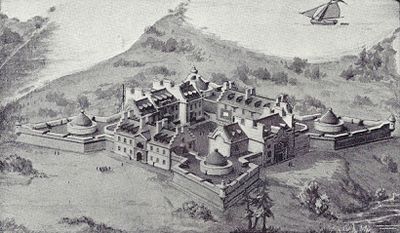Annotation:Fort Augustus: Difference between revisions
No edit summary |
m (Text replacement - "garamond, serif" to "sans-serif") |
||
| (One intermediate revision by one other user not shown) | |||
| Line 1: | Line 1: | ||
'''Back to [[{{BASEPAGENAME}}]]''' | =='''Back to [[{{BASEPAGENAME}}]]'''== | ||
---- | ---- | ||
<p><font face=" | <p><font face="sans-serif" size="4"> | ||
'''FORT AUGUSTUS'''. English, Country Dance (2/4 time). G Major. Standard tuning (fiddle). AABB. Fort Augustus [http://en.wikipedia.org/wiki/Fort_Augustus] is a village on the shores of Loch Ness, in the Scottish Highlands. Its original Gaelic name was displaced after the Jacobite rising of 1715, when the place was fortified by the English and named after the Duke of Cumberland. The village and fort fell to Bonnie Prince Charlie's forces in March, 1746, just before the Battle of Culloden, after which the English quickly retook it. Davis's country dance collection was published some few years after the second Jacobite rebellion, and thus the "Fort Augustus" country dance was a topical title. | '''FORT AUGUSTUS'''. English, Country Dance (2/4 time). G Major. Standard tuning (fiddle). AABB. Fort Augustus [http://en.wikipedia.org/wiki/Fort_Augustus] is a village on the shores of Loch Ness, in the Scottish Highlands. Its original Gaelic name was displaced after the Jacobite rising of 1715, when the place was fortified by the English and named after the Duke of Cumberland. The village and fort fell to Bonnie Prince Charlie's forces in March, 1746, just before the Battle of Culloden, after which the English quickly retook it. Davis's country dance collection was published some few years after the second Jacobite rebellion, and thus the "Fort Augustus" country dance was a topical title. | ||
[[File:fortaugustus.jpg| | [[File:fortaugustus.jpg|400px|thumb|left|Fort Augustus as it looked in 1746]] | ||
<br> | <br> | ||
<br> | <br> | ||
</font></p> | </font></p> | ||
<p><font face=" | <p><font face="sans-serif" size="4"> | ||
''Source for notated version'': | ''Source for notated version'': | ||
<br> | <br> | ||
<br> | <br> | ||
</font></p> | </font></p> | ||
<p><font face=" | <p><font face="sans-serif" size="4"> | ||
''Printed sources'': Davis ('''Twenty Four Country Dances for the Year 1748'''), 1748; No. 1. | ''Printed sources'': Davis ('''Twenty Four Country Dances for the Year 1748'''), 1748; No. 1. | ||
<br> | <br> | ||
<br> | <br> | ||
</font></p> | </font></p> | ||
<p><font face=" | <p><font face="sans-serif" size="4"> | ||
''Recorded sources'': <font color=teal></font> | ''Recorded sources'': <font color=teal></font> | ||
</font></p> | </font></p> | ||
| Line 23: | Line 23: | ||
<br> | <br> | ||
---- | ---- | ||
'''Back to [[{{BASEPAGENAME}}]]''' | =='''Back to [[{{BASEPAGENAME}}]]'''== | ||
Latest revision as of 12:39, 6 May 2019
Back to Fort Augustus
FORT AUGUSTUS. English, Country Dance (2/4 time). G Major. Standard tuning (fiddle). AABB. Fort Augustus [1] is a village on the shores of Loch Ness, in the Scottish Highlands. Its original Gaelic name was displaced after the Jacobite rising of 1715, when the place was fortified by the English and named after the Duke of Cumberland. The village and fort fell to Bonnie Prince Charlie's forces in March, 1746, just before the Battle of Culloden, after which the English quickly retook it. Davis's country dance collection was published some few years after the second Jacobite rebellion, and thus the "Fort Augustus" country dance was a topical title.

Source for notated version:
Printed sources: Davis (Twenty Four Country Dances for the Year 1748), 1748; No. 1.
Recorded sources:
